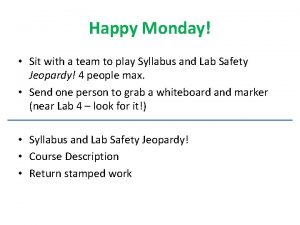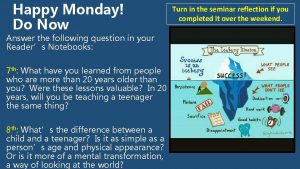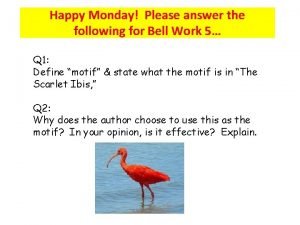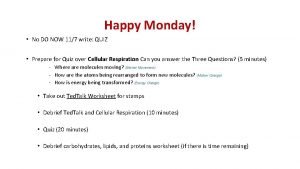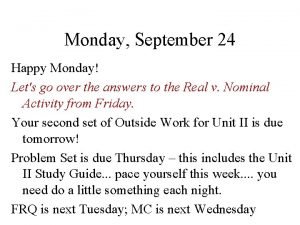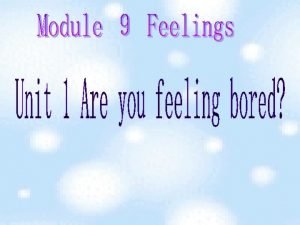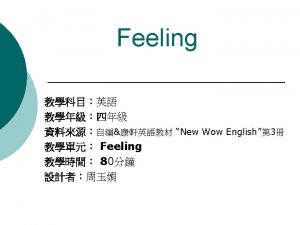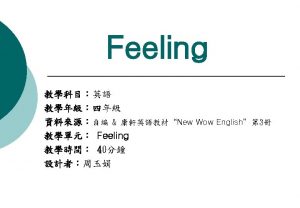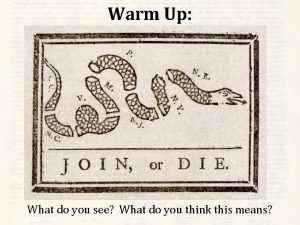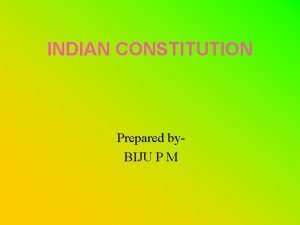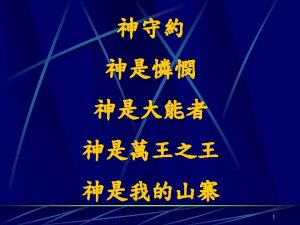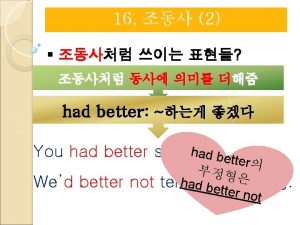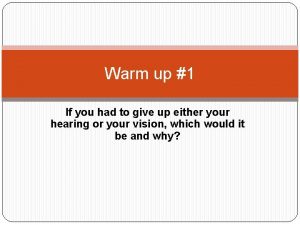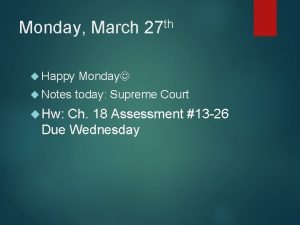Happy Monday 1 If you had to give


























- Slides: 26

Happy Monday! 1. If you had to give up one sense, what would it be? 2. If you could only keep one sense, what would it be?

Sensation • The process by which our sensory receptors and nervous system receive stimulus from the environment Perception • The process of organizing and interpreting sensory information, enabling us to recognize meaningful objects and events


Bottom-Up Processing • Analysis that begins with the sense receptors and works up to the brain's integration of sensory information • Example: piecing lines together to recognize a number • SENSATION Top-Down Processing • Information processing guided by higher-level mental processes • constructing perceptions by drawing on our experiences and expectations • Example: Thinking you know someone and as they get closer, you realize that you don’t • PERCEPTION



Basic Principles of Sensation and Perception

Psychophysics Study of the relationship between physical characteristics of stimuli and our psychological experience of them Gustav Fechner Light (brightness) Sound (volume) Pressure (weight) Taste (sweetness)

Attention Selective Attention • Being aware of a particular stimulus • Basically, what you are paying the most attention to • Can change when something becomes more demanding of your attention • “Cocktail party effect” - able to listen to one voice among many Selective Inattention (Inattentional blindness) • Being unaware of other objects when attention is focused elsewhere • Change blindness – failure to notice changes in environment

Thresholds Absolute – minimum stimulation needed to detect a particular stimulus 50% of the time • Is not constant – can change with motivation and alertness and age • Test your hearing threshold: http: //www. jimmyr. com/blog/hearingloss. html Difference - minimum difference between 2 stimuli required for detection 50% of the time • Just noticeable difference (JND) • Weber's Law – principle that, to be perceived as different, 2 stimuli must differ by a constant percentage, rather than a constant amount • Ernst Henrich Weber • Example: a worker earning $10/hr may need a 50 cent raise to notice the difference, but a $20/hr worker may need a $1. 00 raise to notice. • Light intensity – 8%; weight – 2%, tone frequency 0. 3%




Thresholds continued Signal Detection Theory – predicts how and when we detect the presence of a faint stimulus (signal) amid background stimulation (noise) • Assumes that there is no single absolute threshold • Detection depends partly on a person's experience, expectations, motivation, level of fatigue • Involves decision processes as well as sensory processes

Thresholds continued Signal Detection Theory Examples: • Soldiers fighting noticing suspicious movement/people • Hearing a noise in your house during the middle of the night • Detecting contraband items in airport security • Hearing the phone ring while you are in the shower • Riddle: • You are driving a bus with 12 passengers. At your first stop, 6 passengers get off. At the second stop, 3 get off. At the third stop, 2 more get off, but 3 new people get on. What color are the driver's eyes? • Did you detect the signal? (who is the driver? ) over the noise (number of passengers)

Thresholds continued Subliminal • When stimuli are below one's absolute threshold for conscious awareness • Subliminal messages • http: //www. youtube. com/watch? v=XTu. ALk. U 4 Dwg • Priming- when the exposure to one stimulus influences the response to another stimulus

Habituation Decreased responsiveness/diminished sensitivity to stimuli as a result of constant or repeated stimulation Any change in the stimulation will draw your attention Intentional!

Sensory Adaptation Diminished sensitivity as a consequence of constant stimulation Sensory receptor cells become less responsive to an unchanging stimulus

Examples of Sensory Adaptation Sight- Hearing. Touch. Taste. Smell-

Why we should be glad there are thresholds • What if we could sense everything? • Instead of whole objects, you would see groups of colliding molecules • You would be able to see all the microorganisms on your body, food, etc. • You would be able to hear the blood pumping throughout your body • You would be able to taste stray molecules • You would be able to smell the scents left by animals

Transduction Changing stimulation to sensation The sensory process that converts physical energy, such as light or sound waves, into the form of neural messages • Light energy → vision • Chemical energy → smell and taste • Sound waves → sound Information goes from the senses to the thalamus, then to the various areas of the brain

Stimulation -> Perception 1. Physical stimulation (ex: light waves from the butterfly) are transduced by the eye, where information about the wavelength and intensity of the light is coded into neural signals 2. The neural messages travel to the sensory cortex of the brain, where they become sensations of color, brightness, form, and movement 3. Finally, the process of perception interprets these sensations by making connections with memories, expectations, emotions, and motives in other parts of the brain


After constant exposure to a stimulus, our nerve cells fire less frequently. This can be explained by which of the following? a. b. c. d. e. Weber’s Law Sensory adaptation Signal detection Absolute threshold sensitivity The phi phenomenon

The ability of the human visual system to barely detect a candle flame at a distance of about 30 miles on a clear, dark night is an example of A. B. C. D. E. An absolute threshold A difference threshold Just noticeable difference Weber’s law Fechner’s law

ALL ABOUT VISION! Our eyes receive light energy and transduce (transform) it into neural messages that our brain then processes into what we consciously see When you look at a bright red tulip, what strikes your eyes is not particles of the color red but pulses of electromagnetic energy that your visual system perceives as red Wavelength- distance from one wave peak to the next Determines the hue! Amplitude- the wave’s height Determines the brightness/intensity!
 Happy monday hope you had a great weekend
Happy monday hope you had a great weekend You are happy i am happy
You are happy i am happy I (to have) breakfast before i went to school
I (to have) breakfast before i went to school Happy monday quiz
Happy monday quiz Happy monday team
Happy monday team Happy monday answer key
Happy monday answer key Happy fake monday
Happy fake monday Good afternoon monday
Good afternoon monday Good morning pics
Good morning pics Happy monday november
Happy monday november Happy monday november 1st
Happy monday november 1st Response to happy monday
Response to happy monday Happy monday jr password
Happy monday jr password Good morning happy monday december
Good morning happy monday december Response to happy monday
Response to happy monday Econmovies episode 3 worksheet answers
Econmovies episode 3 worksheet answers Character chart for the outsiders answers
Character chart for the outsiders answers Happy monday quiz
Happy monday quiz Do not confuse theme with a story's
Do not confuse theme with a story's Econmovies episode 6 back to the future worksheet answers
Econmovies episode 6 back to the future worksheet answers Happy monday welcome back
Happy monday welcome back Bored hape
Bored hape Hungry happy sad
Hungry happy sad Happy sad surprised angry
Happy sad surprised angry Happy feet underlay
Happy feet underlay What is the main idea of give me liberty or give me death
What is the main idea of give me liberty or give me death Key features of indian constitution
Key features of indian constitution




